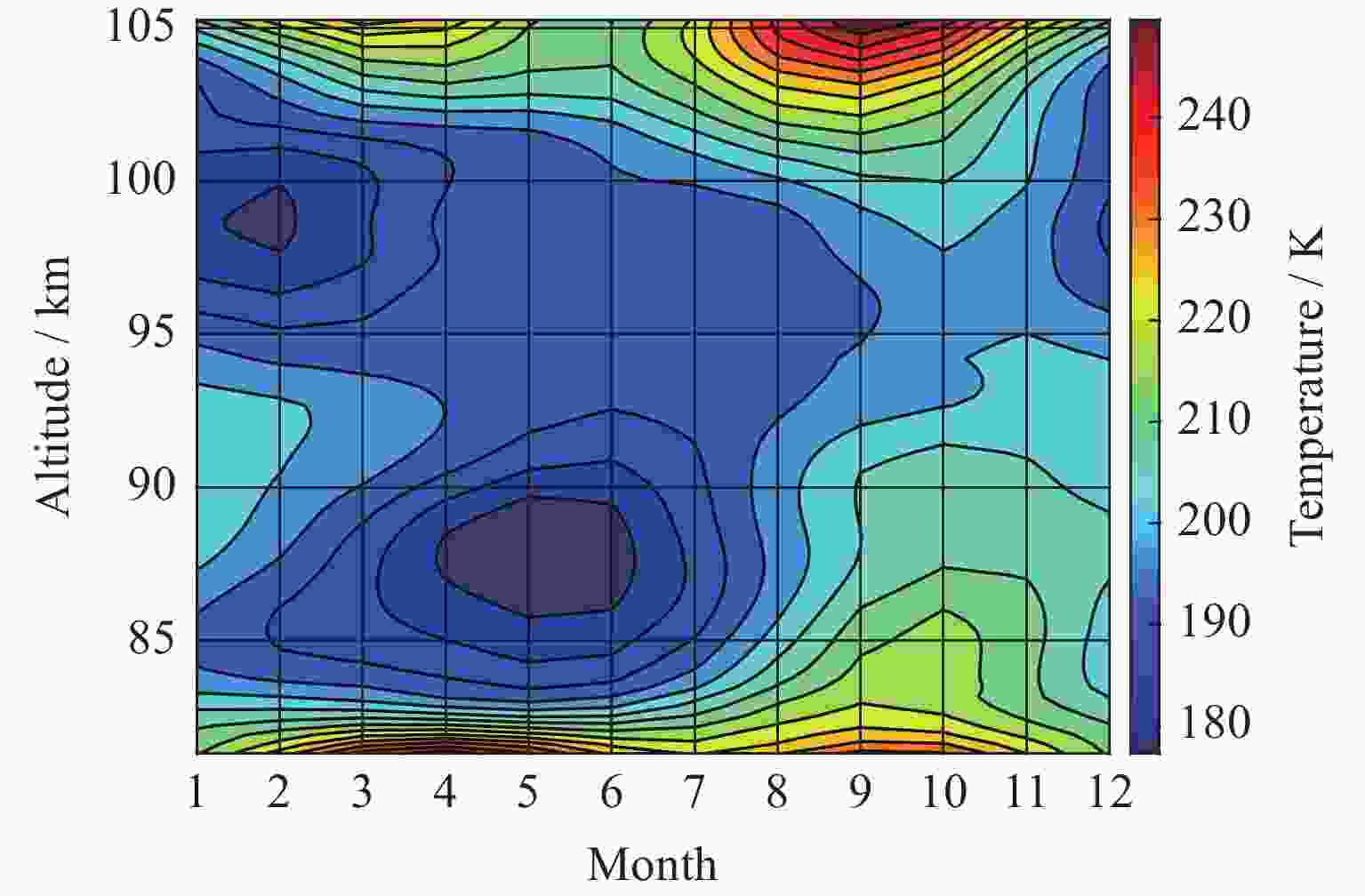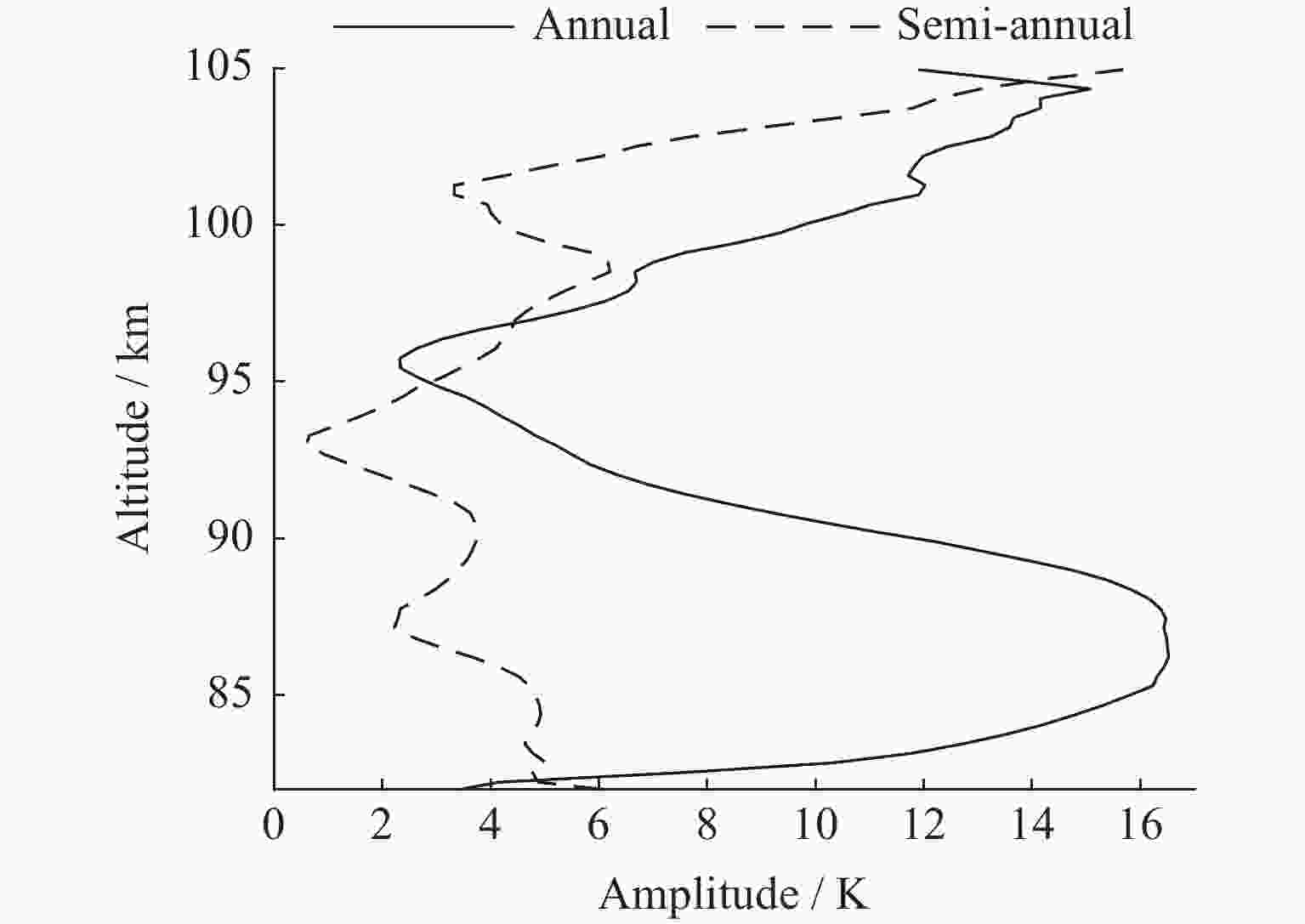基于钠激光雷达观测数据的中间层顶大气温度分布特性研究
doi: 10.11728/cjss2022.05.210901096 cstr: 32142.14.cjss2022.05.210901096
Studies for Mesopause Temperature Distribution Characteristics Based on the Sodium Lidar Data
-
摘要: 作为中间层和热层的边界层,中间层顶存在多种能量交换方式,是大气能量耦合的重要区域。本文利用部署于中国科学院廊坊临近空间大气探测站的钠荧光多普勒激光雷达2013年的观测数据,研究了廊坊上空中间层顶区域大气温度的年度和季节分布特性,并分析了影响温度分布的多种因素。年平均温度廓线图显示,中间层顶位于约97.5 km高度处,温度约191.2 K。受放热化学反应的影响,年平均温度廓线91 km高度处出现了一个198 K的相对温度高点。中间层顶区域大气温度的季节分布受太阳辐射和大气动力学因素综合影响,夏季在大气动力学影响下,中间层顶高度较低,位于88 km高度处,温度也较低,约177 K;冬季太阳辐射起主导作用,中间层顶位于99 km高度处,温度为181 K。通过拟合月平均温度分析了中间层顶区域大气温度年变化和半年变化的振幅和相位特征。结果显示,中间层顶区域上部温度分布主要受太阳辐射的影响;在中间层顶区域下部,大气波动主导了温度分布。Abstract: As the boundary of mesosphere and thermosphere, mesopause is an important area for studying the middle and upper atmosphere, many energy coupling processes happen here, study for the temperature distribution characters will improve our understanding of the climatology of this region. This paper studies the annual and seasonal temperature distribution characteristics based on the Langfang sodium lidar data in 2013. Results show that, the annual mean mesopause locates at around 97.5 km with the temperature 191.2 K. Under the influence of exothermic chemical reactions, there is a relative maximum temperature 198 K at 91 km on the annual profile. The seasonal temperature at mesopause region is influenced by solar radiation and atmospheric dynamics. In winter, solar radiation is the primary factor, producing a higher mesopause of 181 K at 99 km altitude. In summer, the rising atmosphere from lower altitude makes a colder mesopause at 88 km altitude with the temperature 177 K. Harmonic analysis demonstrates a strong change in annual amplitudes over a rather small altitude range, coupling with the annual phase profile, and it is shown that dynamics in lower mesopause region and solar radiation in upper mesopause region play the key role in determining the thermal structure respectively.
-
Key words:
- Laser optics /
- Sodium Lidar /
- Atmospheric temperature /
- Mesopause
-
表 1 廊坊钠荧光多普勒激光雷达系统参数
Table 1. Langfang sodium fluorescence Doppler lidar system parameters
系统参数 参数值 激光波长/nm 589.2 频率调节值/MHz ±630 脉冲能量/mJ 300 脉冲宽度/ns 8 发散角/mrad 1 脉冲频率/Hz 30 望远镜口径/m 1 视场角/mrad 2 滤波器带宽/nm 1 时间分辨率/min 1 高度分辨率/m 76.5 -
[1] 操文祥. 中间层顶与湍流层顶的SABER/TIMED观测研究[D]. 武汉: 武汉大学, 2012CAO Wenxiang. Observations of Atmospheric Mesopause and Wave Turbopause by SABER/TIMED Satellite[D]. Wuhan: Wuhan University, 2012 [2] BOWMAN M R, GIBSON A J, SANDFORD M C W. Atmospheric sodium measured by a tuned laser radar[J]. Nature, 1969, 221(5179): 456-457 doi: 10.1038/221456a0 [3] MEGIE G, BLAMONT J E. Laser sounding of atmospheric sodium interpretation in terms of global atmospheric parameters[J]. Planetary and Space Science, 1977, 25(12): 1093-1109 doi: 10.1016/0032-0633(77)90085-X [4] FRICKE K H, VON ZAHN U. Mesopause temperatures derived from probing the hyperfine structure of the D2 resonance line of sodium by lidar[J]. Journal of Atmospheric and Terrestrial Physics, 1985, 47(5): 499-512 doi: 10.1016/0021-9169(85)90116-3 [5] PHILBRICK C P, YANG F, VARGAS F A, et al. A Na density lidar method and measurements of turbulence to 105 km at the Andes Lidar Observatory[J]. Journal of Atmospheric and Solar–Terrestrial Physics, 2021, 219: 105642 doi: 10.1016/j.jastp.2021.105642 [6] HU X, GARDNER C S, LIU A Z. Seasonal and nocturnal variations of the mesospheric sodium layer at Starfire Optical Range, New Mexico[J]. Chinese Journal of Geophysics, 2003, 46(3): 432-437 doi: 10.1002/cjg2.3360 [7] CHU X Z, CHEN Y F, CULLENS C Y, et al. Mid-latitude thermosphere-ionosphere Na (TINa) layers observed with high-sensitivity Na Doppler lidar over boulder (40.13°N, 105.24°W)[J]. Geophysical Research Letters, 2021, 48(11): e2021GL093729 doi: 10.1029/2021GL093729 [8] 胡雄, 闫召爱, 郭商勇, 等. 钠荧光多普勒激光雷达测量中间层顶区域大气温度[J]. 科学通报, 2011, 56(4): 247-253HU Xiong, YAN Zhaoai, GUO Shangyong, et al. Sodium fluorescence Doppler lidar to measure atmospheric temperature in the mesopause region[J]. Chinese Science Bulletin, 2011, 56(4): 417-423 [9] SHE C Y, CHEN S S, HU Z L, et al. Eight-year climatology of nocturnal temperature and sodium density in the mesopause region (80 to 105 km) over Fort Collins, CO (41°N, 105°W)[J]. Geophysical Research Letters, 2000, 27(20): 3289-3292 doi: 10.1029/2000GL003825 [10] ROBERT J S, CHESTER S G. Thermal structure of the mesopause region (80–105 km) at 40°N latitude. Part I: Seasonal variations[J]. Journal of The Atmospheric Sciences, 2000, 57: 66-77 [11] MLYNCZAK M G, SOLOMON S. Middle atmosphere heating by exothermic chemical reactions involving odd-hydrogen species[J]. Geophysical Research Letters, 1991, 18(1): 37-40 doi: 10.1029/90GL02672 [12] YU J R, SHE C Y. Climatology of a midlatitude mesopause region observed by a lidar at Fort Collins, Colorado (40.6°N, 105°W)[J]. Journal of Geophysical Research, 1995, 100(D4): 7441-7452 doi: 10.1029/94JD03109 [13] GARCÍA-COMAS M, LÓPEZ-PUERTAS M, MARSHALL B T, et al. Errors in sounding of the atmosphere using broadband emission radiometry (SABER) kinetic temperature caused by non-local-thermodynamic-equilibrium model parameters[J]. Journal of Geophysical Research, 2008, 113(D24): D24106 doi: 10.1029/2008JD010105 [14] SHE C Y, VON ZAHN U. Concept of a two-level mesopause: support through new lidar observations[J]. Journal of Geophysical Research, 1998, 103(D5): 5855-5863 doi: 10.1029/97JD03450 [15] XU J Y, LIU H L, YUAN W, et al. Mesopause structure from thermosphere, ionosphere, mesosphere, energetics, and dynamics (TIMED)/sounding of the atmosphere using broadband emission radiometry (SABER) observations[J]. Journal of Geophysical Research, 2007, 112(D9): D09102 doi: 10.1029/2006JD007711 [16] RAMESH K, SRIDHARAN S, RAGHUNATH K, et al. Planetary wave-gravity wave interactions during mesospheric inversion layer events[J]. Journal of Geophysical Research, 2013, 118(7): 4503-4515 doi: 10.1002/jgra.50379 -
-






 下载:
下载:









